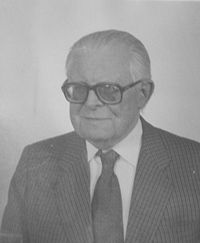
Lexicon Mediae et Infimae Latinitatis Polonorum
Encyclopedia
Lexicon Mediae et Infimae Latinitatis Polonorum (Polish
Słownik łaciny średniowiecznej w Polsce) is the most comprehensive dictionary of the Latin language as was used in Poland
from the 10th to the middle of the 16th century. Administratively, the dictionary belongs to the Institute of the Polish Language, Cracow, which is incorporated in the Polish Academy of Sciences
.
in 1920, which aimed to compile a great common dictionary of Medieval Latin
based on excerpts from the different national sources. The initiative eventually resulted in the establishment of a number of separate, national dictionaries. In Poland
, preparatory work started immediately (under the auspices of the Polish Academy of Learning
), and the majority of the excerpts were collected in the years 1924–1939. Subsequently, due to the outbreak of the Second World War
, progress on the dictionary was impeded for some years.
 The first fascicle was only published in 1953, under the direction of the late Prof. Marian Plezia
The first fascicle was only published in 1953, under the direction of the late Prof. Marian Plezia
(1917–1996), longstanding editor of the Lexicon until his retirement in 1988. Prof. Krystyna Weyssenhoff–Brozkowa (1934–2007) was appointed as his successor, and performed the function until 2005, when Michał Rzepiela was appointed editor. The editorial team numbers six persons.
Polish language
Polish is a language of the Lechitic subgroup of West Slavic languages, used throughout Poland and by Polish minorities in other countries...
Słownik łaciny średniowiecznej w Polsce) is the most comprehensive dictionary of the Latin language as was used in Poland
Poland
Poland , officially the Republic of Poland , is a country in Central Europe bordered by Germany to the west; the Czech Republic and Slovakia to the south; Ukraine, Belarus and Lithuania to the east; and the Baltic Sea and Kaliningrad Oblast, a Russian exclave, to the north...
from the 10th to the middle of the 16th century. Administratively, the dictionary belongs to the Institute of the Polish Language, Cracow, which is incorporated in the Polish Academy of Sciences
Polish Academy of Sciences
The Polish Academy of Sciences, headquartered in Warsaw, is one of two Polish institutions having the nature of an academy of sciences.-History:...
.
History
As with similar dictionaries in other European countries, the origins of the Lexicon Mediae et Infimae Latinitatis Polonorum go back to a project launched through the Union Académique InternationaleUnion Académique Internationale
The Union Académique Internationale is the oldest and largest federation of Academies having a national character and created for international cooperation...
in 1920, which aimed to compile a great common dictionary of Medieval Latin
Medieval Latin
Medieval Latin was the form of Latin used in the Middle Ages, primarily as a medium of scholarly exchange and as the liturgical language of the medieval Roman Catholic Church, but also as a language of science, literature, law, and administration. Despite the clerical origin of many of its authors,...
based on excerpts from the different national sources. The initiative eventually resulted in the establishment of a number of separate, national dictionaries. In Poland
Poland
Poland , officially the Republic of Poland , is a country in Central Europe bordered by Germany to the west; the Czech Republic and Slovakia to the south; Ukraine, Belarus and Lithuania to the east; and the Baltic Sea and Kaliningrad Oblast, a Russian exclave, to the north...
, preparatory work started immediately (under the auspices of the Polish Academy of Learning
Polish Academy of Learning
The Polish Academy of Arts and Sciences or Polish Academy of Learning , headquartered in Kraków, is one of two institutions in contemporary Poland having the nature of an academy of sciences....
), and the majority of the excerpts were collected in the years 1924–1939. Subsequently, due to the outbreak of the Second World War
World War II
World War II, or the Second World War , was a global conflict lasting from 1939 to 1945, involving most of the world's nations—including all of the great powers—eventually forming two opposing military alliances: the Allies and the Axis...
, progress on the dictionary was impeded for some years.

Marian Plezia
Marian Plezia was a Polish historian. He was an expert of medieval Polish history and author of a Latin-Polish dictionary and Medieval Latin-Polish dictionary.-Selected bibliography:...
(1917–1996), longstanding editor of the Lexicon until his retirement in 1988. Prof. Krystyna Weyssenhoff–Brozkowa (1934–2007) was appointed as his successor, and performed the function until 2005, when Michał Rzepiela was appointed editor. The editorial team numbers six persons.
List of fascicles
Since 1953, seventy fasciscles have been published, making up the seven volumes completed to date (A–Q) plus most of the eighth volume (as of 2010, R–Specificative)..- Vol. I (fascs. 1–8): A–Byssus
- Vol. II (fascs. 1(9)–10(18)): Cabaciolum–Czweczko
- Vol. III (fascs. 1(19)–10(28)): Dabilis–Exuvium
- Vol. IV (fascs. 1(29)–6(34)): F–Hystrix
- Vol. V (fascs. 1(35)–10(44)): I–Lyrista
- Vol. VI (fascs. 1(45)–8(51)): M–Oxymel
- Vol. VII (fascs. 1(52)–11(62): Pabulamen–Quout
- Vol. VIII (fascs. 1(63)–8(70)): Rabalipton–Specificative
See also
- Marian PleziaMarian PleziaMarian Plezia was a Polish historian. He was an expert of medieval Polish history and author of a Latin-Polish dictionary and Medieval Latin-Polish dictionary.-Selected bibliography:...
- Dictionary of Medieval Latin from British SourcesDictionary of Medieval Latin from British SourcesThe Dictionary of Medieval Latin from British Sources is a lexicon of Medieval Latin, published by Oxford University Press for the British Academy, and sometimes referred to as simply the Dictionary of Medieval Latin or the Medieval Latin Dictionary. After decades of preparatory work, the...
- Medieval LatinMedieval LatinMedieval Latin was the form of Latin used in the Middle Ages, primarily as a medium of scholarly exchange and as the liturgical language of the medieval Roman Catholic Church, but also as a language of science, literature, law, and administration. Despite the clerical origin of many of its authors,...

